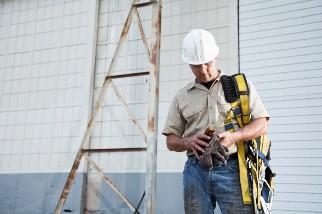Falls from height are a leading cause of workplace injuries and fatalities, and fall protection was the most frequently cited OSHA standard in FY 2020. Proper training can help prevent these incidents and help your team know how to operate safety when
working at height.
protection was the most frequently cited OSHA standard in FY 2020. Proper training can help prevent these incidents and help your team know how to operate safety when
working at height.
“Fall protection training is not just a ‘check the box’ exercise,” says Adam Rubin, CSP, corporate safety director at Zachry Group. “There's nothing more crucial or quintessential to a great fall protection program than having
a great training program that supports it.”
If you’re looking to establish a fall protection training program or improve your current training, use these three tips to educate workers on operating safely.
1. Start With the Basics
Whether a worker is using fall protection equipment for the first time or has spent their entire career operating at height, they need to know the fundamentals of how to stay safe. Rubin suggests beginning with topics such as harness sizing and fitting
so workers recognize that proper fit of equipment is critical to staying safe on the job site.
“No matter how much experience people have, it helps to take them back to the basics and the fundamentals,” he says. “If a harness isn’t adjusted properly to your body, then it is not hitting you at the right spots and you will
not be protected as well as you could be during a fall.”
From there, you can teach workers about other equipment such as lanyards, lanyard extensions and scaffolding so that they know how to stay safe regardless of their experience level or the type of equipment they are using.
“Providing equipment is one thing,” Rubin explains. “Showing workers how to use it in different environments is the next. You want workers to practice using equipment over and over again, so that when it comes time to use it in the field,
they know what decision to make, and they’ll make the right decision every time.”
2. Simulate the Work Environment
Working at height involves many different tasks and scenarios. Whether operating on a rooftop, scaffolding or another environment, workers need to visualize and understand the circumstances they will encounter. Simulating those environments and scenarios
is a key part of training.
“I believe you have to have a safe environment for people to make mistakes,” he explains. “A fall protection simulator allows you to run your employees through the different components using different fall protection equipment that may
be needed on a specific project.”
One example is a simulator that trains workers who operate on scaffolding how to perform their tasks and traverse a scaffold while remaining tied off the entire time. Rubin says this kind of training helps workers understand how to make the right decisions
and recognize the potential consequences if something goes wrong.
“Learning what no to do might be just as important as learning what to do,” Rubin says. “Being able to have an environment that’s live and experiential, where you can make mistakes, will make employees that much better when they’re
out in the field making the right decisions.”
3. Practice, Practice, Practice
Once you’ve taught workers how to use their equipment and developed a simulated work environment, the next step is to have workers practice using that equipment in those environments. If workers learn the proper steps in training and practice, they
are more likely to do the same on the job.
“You practice like you play. With fall protection, we’re playing for keeps,” Rubin says. “It’s a life-and-death situation, so training is especially crucial.”
It’s also important to remember that training should not be a one-and-done experience. Working conditions constantly change, so workers should receive regular refresher training throughout the duration of the project.
“Repetition is key,” Rubin explains. “Our employees go through training before they’re allowed to get a harness and go to work as a part of their initial orientation, but they go through it once a quarter while they’re still
working on that job.”
Listen to our podcast episode featuring Adam Rubin, CSP, for more tips on how to improve your fall protection training program.
Workplace Falls Are Preventable
Our Fall Protection Safety Toolbox has resources you need to identify and control risks, provide relevant training, and protect workers at height.
Learn more